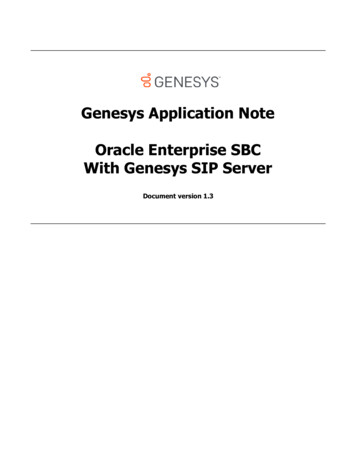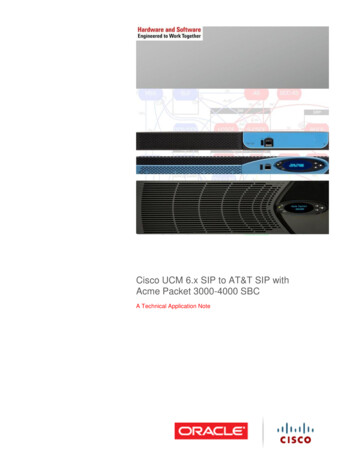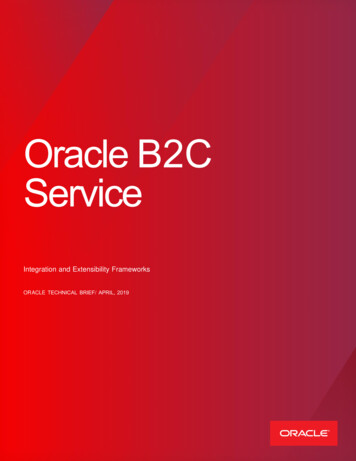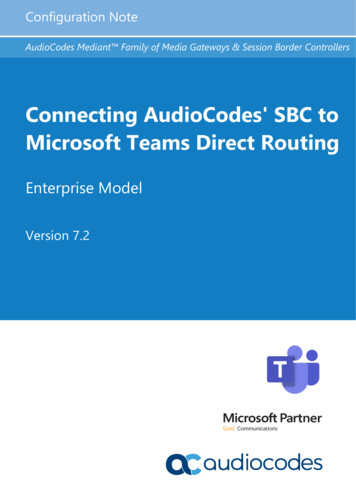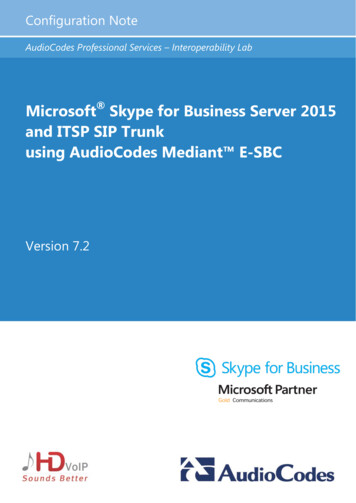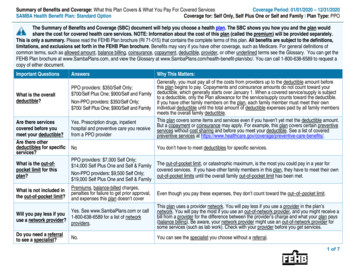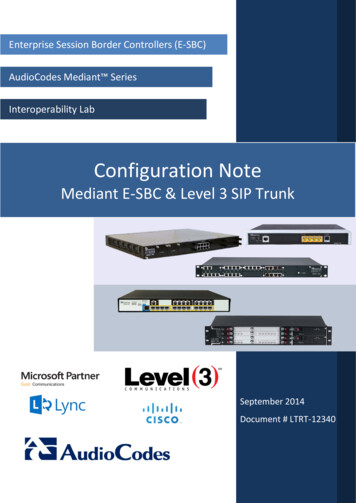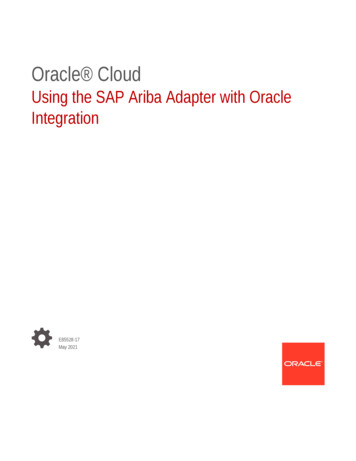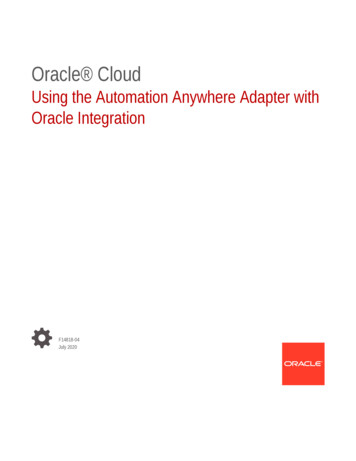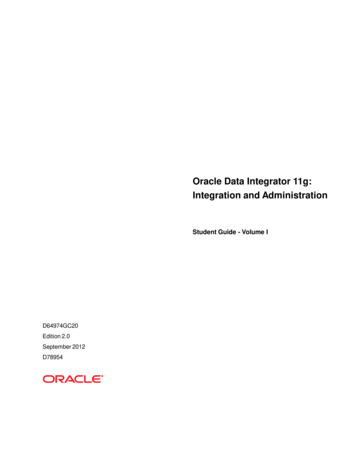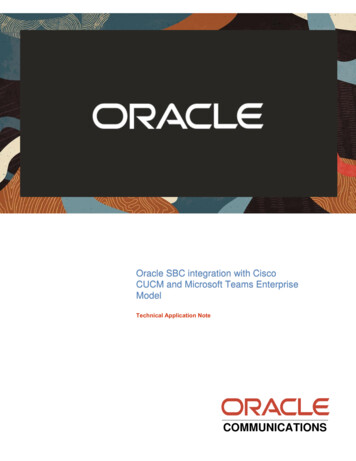
Transcription
Oracle SBC integration with CiscoCUCM and Microsoft Teams EnterpriseModelTechnical Application NoteCOMMUNICATIONS
DisclaimerThe following is intended to outline our general product direction. It is intended for information purposes only, and may not beincorporated into any contract. It is not a commitment to deliver any material, code, or functionality, and should not be reliedupon in making purchasing decisions. The development, release, and timing of any features or functionality described forOracle’s products remains at the sole discretion of Oracle.Revision HistoryVersionDescription of ChangesDate Revision Completed1.0Oracle SBC integration withCisco CUCM and MicrosoftTeams Enterprise Model21st February 20202 Page
Table of Contents1. INTENDED AUDIENCE .52. DOCUMENT OVERVIEW .53. INTRODUCTION .73.1. AUDIENCE. 73.2. REQUIREMENTS. 73.3. ARCHITECTURE . 84. CONFIGURING THE CISCO CUCM .94.1. CONFIGURING A NEW SIP TRUNK . 94.2. CONFIGURE A NEW ROUTE PATTERN . 115. REQUIREMENTS TO CONFIGURE MICROSOFT TEAMS DIRECT ROUTING . 145.1. TENANT REQUIREMENTS . 145.2. LICENSING REQUIREMENTS . 145.3. DNS REQUIREMENTS . 145.4. SBC DOMAIN NAMES . 145.5. PUBLIC TRUSTED CERTIFICATE FOR THE SBC. 166. CONFIGURE TEAMS DIRECT ROUTING . 176.1. ESTABLISH A REMOTE POWERSHELL SESSION . 176.2. PAIR THE SBC TO THE TENANT . 186.3. ENABLE USERS FOR DIRECT ROUTING. . 206.4. ASSIGN A PHONE NUMBER TO THE USER . 216.5. CONFIGURE VOICE ROUTING. 217. MICROSOFT TEAMS DIRECT ROUTING INTERFACE CHARACTERISTICS . 238. CONFIGURING THE SBC . 258.1. VALIDATED ORACLE SBC VERSION . 259. NEW SBC CONFIGURATION . 259.1. ESTABLISHING A SERIAL CONNECTION TO THE SBC . 259.2. CONFIGURE SBC USING WEB GUI . 309.3. CONFIGURE SYSTEM-CONFIG . 329.4. CONFIGURE PHYSICAL INTERFACE VALUES . 339.5. CONFIGURE NETWORK INTERFACE VALUES. 349.6. ENABLE MEDIA MANAGER . 379.7. CONFIGURE REALMS. 389.8. ENABLE SIP-CONFIG. 399.9. CONFIGURING A CERTIFICATE FOR SBC . 409.10. TLS-PROFILE . 449.11. CONFIGURE SIP INTERFACES. . 459.12. CONFIGURE SESSION-AGENT . 469.13. CONFIGURE SESSION-AGENT GROUP . 509.14. CONFIGURE LOCAL-POLICY . 519.15. CONFIGURE MEDIA PROFILE AND CODEC POLICY . 539.16. CONFIGURE STEERING-POOL . 569.17. CONFIGURE SDES PROFILE . 579.18. CONFIGURE MEDIA SECURITY PROFILE . 589.19. CONFIGURE RTCP POLICY AND RTCP MUX . 593 Page
10. EXISTING SBC CONFIGURATION . 61APPENDIX A . 624 Page
1. Intended AudienceThis document is intended for use by Oracle Systems Engineers, third party Systems Integrators,Oracle Enterprise customers and partners and end users of the Oracle Enterprise Session BorderController (SBC). It is assumed that the reader is familiar with basic operations of the OracleEnterprise Session Border Controller platform along with Microsoft Teams Direct Routing EnterpriseModel and Cisco CUCM.2. Document OverviewThis Oracle technical application note outlines the configuration needed to set up the interworkingbetween on premises Cisco CUCM and Microsoft's Teams Enterprise Model(Cloud based) using OracleSBC. The solution contained within this document has been tested using Oracle Communication OS830m1p2 version. Our scope of this document is only limited to testing Teams Enterprise Model withCisco CUCM.Microsoft Teams Direct Routing lets you connect a supported, customer-provided Session BorderController (SBC) to Microsoft Phone System. With Direct Routing, you can connect your SBC to almostany telephony trunk or interconnect with third-party Public Switched Telephone Network (PSTN)equipment. Direct Routing enables you to: Use virtually any PSTN trunk with Microsoft Phone System.Configure interoperability between customer-owned telephony equipment, such as a third-partyprivate branch exchange (PBX), analog devices, and Microsoft Phone System.Microsoft Teams works on two different methods which is given below:1) Media bypassMedia bypass shortens the path of media traffic and reduces the number of hops in transitfor better performance. With media bypass, media is kept between the Session BorderController (SBC) and the client instead of sending it via the Microsoft Phone System.For more information on media bypass, please read the links given t/SBC-MSFTTeamsMB.pdf2) Non-media bypassWithout media bypass, when a client makes or receives a call, both signaling andmedia flow between the SBC, the Microsoft Phone System, and the Teams client.For more information on media bypass, please read the links given /acmepacket/Microsoft/SBC-MSFTTeamsNONMB.pdf5 Page
Cisco Unified Call Manager provides industry-leading reliability, security, scalability, efficiency, andenterprise call and session management and is the core call control application of the collaborationportfolio.It should be noted that while this application note focuses on the optimal configurations for the Oracle SBCin an enterprise Cisco CUCM 11.5 environment, the same SBC configuration model can also be used forother enterprise applications with a few tweaks to the configuration for required features.In addition, it should be noted that the SBC configuration provided in this guide focuses strictly on theCisco CUCM Server associated parameters. Many SBC applications may have additional configurationrequirements that are specific to individual customer requirements. These configuration items are notcovered in this guide. Please contact your Oracle representative with any questions pertaining to thistopic.Please note that the IP address, FQDN and config name and its details given in this documentis used as reference purpose only. The same details cannot be used in customer config andthe end users can use the configuration details according to their network requirements.For additional information on CUCM 11.5, please sion-11-5/index.html6 Page
3. Introduction3.1. AudienceThis is a technical document intended for telecommunications engineers with the purpose of configuringTeams Direct Routing Enterprise Model with Cisco CUCM 11.5 version using Oracle Enterprise SBC.There will be steps that require navigating the CUCM 11.5 server configuration, Oracle SBC GUI interface,understanding the basic concepts of TCP/UDP, IP/Routing, DNS server and SIP/RTP are also necessaryto complete the configuration and for troubleshooting, if necessary.3.2. Requirements Fully functioning Cisco UCM 11.5Oracle Enterprise Session Border Controller (hereafter Oracle SBC) running 8.3.0 versionTeams Direct Routing Enterprise Model running Teams Client.The below revision table explains the versions of the software used for each component:This table is Revision 1 as of now:Software UsedRevision 1CUCM Version11.5SBC Version8.3.0Teams Client version1.3.00.362 (64-bit)(Windows)v.2020.1.14.4i.USWE2.2 (Mobile)7 Page
3.3. ArchitectureThe configuration, validation and troubleshooting is the focus of this document and will be described inthree phases: Phase 1 – Configuring the Cisco Unified Call Manager v11.5 for Oracle SBCPhase 2 – Configuring the Teams Direct Routing Enterprise Model.Phase 3 – Configuring the Oracle SBC8 Page
4. Configuring the Cisco CUCMPlease login to Cisco CUCM admin web GUI with proper login credentials (Username and password).After that, perform the steps below in the given order.4.1. Configuring a new SIP Trunk01) Go to Device ----- Trunk ----- Add New02) Select Trunk Type – SIP Trunk and then Click Next03) In the Device Name field, enter the SIP Trunk name and optionally provide a description.04) In the Device Pool drop-down list, select a device pool id created already else select Default05) Enter the Destination Address and Destination Port of the SBC under SIP Information.06) Select appropriate SIP profile and SIP trunk security profile from the dropdown menu.07) Click Save9 Page
10 P a g e
4.2. Configure a new Route Pattern01) Go to Call Routing ------ Route/Hunt ------ Route Pattern and click Add New02) Enter a Route Pattern according to the network requirements and calling plan.03) From the Gateway/Route List drop-down list, select the created SIP Trunk device name.04) Click Save.11 P a g e
12 P a g e
The route pattern that has been created is shown below:The created SIP trunk associated wuth the route pattern is shown below:With these steps, the CUCM config to the SBC is complete.13 P a g e
5. Requirements to Configure Microsoft Teams Direct RoutingIf you are planning to configure direct routing with Oracle SBC, you must ensure that the followingprerequisites are completed before proceeding further Tenant requirementsLicensing and other requirementsSBC domain namesPublic trusted certificate for the SBCSIP Signaling: FQDNs5.1. Tenant RequirementsMake sure that you have a custom domain on your O365 tenant. Here we have created an ise create an account, which is not the default domain created for your tenant. For more oftteams/direct-routing-plan#sbc-domain-names5.2. Licensing RequirementsMake sure that the following license requirements are met by the Direct routing users.(ie the users mustbe assigned the following licenses in Office 365) Microsoft Phone SystemMicrosoft Teams Skype for Business Plan 2 if included in Licensing SKU5.3. DNS RequirementsCreate DNS records for domains in your network that resolve to your SBC.Before you begin, make sure that you have the following per every SBC you want to pair:-Public IP addressFQDN name resolving to the Public IP address5.4. SBC Domain NamesThe SBC domain name must be from one of the names registered in “Domains” of the tenant.You cannot use the *.onmicrosoft.com tenant for the domain name.For example, on the picture below, the administrator registered the following DNS names for the tenant:14 P a g e
DNS NameCan be used forExamples of FQDN namesSBC FQDNValid names: woodgrovebank.usYesNon-Valid name: .ussbc1.europe.woodgrovebank.us (requiresregistering domain name europe.atatum.biz in“Domains” first)Using *.onmicrosoft.com domains is notsupported for SBC namesValid names:hybrdvoice.orgYes sbc1. hybridvoice.orgussbcs15. hybridvoice.orgeurope. hybridvoice.orgNon-Valid name: sbc1.europe.hybridvoice.org (requiresregistering domain name europe.hybridvoice.org in “Domains” first)Please activate and register the domain of tenant.15 P a g e
In this document the following FQDN and IP is used as an example:Public IPFQDN . Public trusted certificate for the SBCIt is necessary to setup a public trusted certificate for direct routing. This certificate is used to establishTLS connection between Oracle SBC and MS Teams. The certificate needs to have the SBC FQDN in thesubject, common name, or subject alternate name fields.For root certificate authorities used to generate SBC certificate, refer Microsoft ificate-for-the-sbc16 P a g e
6. Configure Teams Direct RoutingThe SBC has to be paired with the direct routing interface for direct routing to work. To achieve this followthe below steps6.1. Establish a remote PowerShell sessionThe first step is to download Microsoft PowerShell.For more information and downloading the client, visit Microsoft’s set-up-your-computer-for-windows-powershell.To establish a remote connection, follow the below stepsOpen PowerShell and type in the below commands Import-Module SkypeOnlineConnector userCredential Get-Credential sfbSession New-CsOnlineSession -Credential userCredentialImport-PSSession sfbSessionPowerShell prompts for a username and password. Enter the tenant username and password.Tenants are used in pairing the SBC with the direct routing interface.17 P a g e
Now the remote connection is established.Check whether the remote connection is proper by using the below command“Get-Command *onlinePSTNGateway*”The command will return the four functions shown here that will let you manage the SBC.6.2. Pair the SBC to the tenantTo pair SBC to the tenant, type the command as shown below. Here the FQDN used y -Fqdn SBC FQDN -SipSignallingPort SBC SIP Port MaxConcurrentSessions Max Concurrent Sessions the SBC can handle -Enabled trueFor more information ,please visit the Microsoft documentation siness-online-by-using-powershell18 P a g e
After pairing, we can check whether the SBC is present in the list of paired SBC’s by typing in thecommand:Get-CsOnlinePSTNGateway -Identity oracleesbc2.woodgrovebank.usThe details of the gateway are listed when the above command is entered.Verify whether the enabled parameter is set to true.The OPTIONS ping from the SBC is now responded with 200OK.Once there are incoming options to the direct routing interface, it starts sending OPTIONS to the SBC.19 P a g e
6.3. Enable Users for Direct Routing.To add users, create a user in Office 365 and assign a license. Here the following user is created:teamsuser1@woodgrovebank.usHere the following license is added- Office 365 Enterprise E5 (including SfB Plan2, Exchange Plan2, Teams, and Phone System)Verify wh
Controller (SBC). It is assumed that the reader is familiar with basic operations of the Oracle Enterprise Session Border Controller platform along with Microsoft Teams Direct Routing Enterprise Model and Cisco CUCM. 2. Document Overview This Oracle technical application note out
